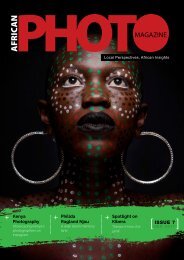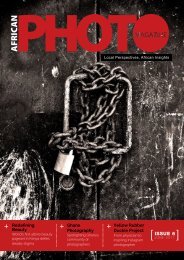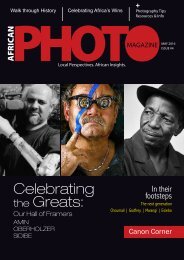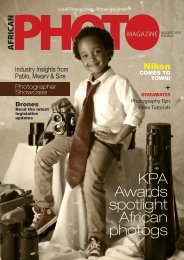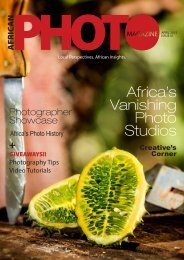African Photo Magazine Issue #8
We are particularly delighted to publish, in this issue, photographers showcasing studio photography talent that echoes the work of one of Africa’s greats, Malick Sidibé (1936–2016). Photographers Hassan Hajjaj, Omar Diop and Samuel Fosso have stayed true to the photographic style that made Mr Sidibé’s work legendary. The portraitures are uniquely stylish and follow signature themes that clearly identify each photographers artistic bent. The work of this trio speaks to the heart of this publication, the genesis of which was to not only celebrate contemporary African photography but to reach back and illuminate the artistry and creativity of our forefathers and those that came before us, and to never forget that we stand on the shoulders of giants.
We are particularly delighted to publish, in this issue, photographers showcasing studio photography talent that echoes the work of one of Africa’s greats, Malick Sidibé (1936–2016). Photographers Hassan Hajjaj, Omar Diop and Samuel Fosso have stayed true to the photographic style that made Mr Sidibé’s work legendary. The portraitures are uniquely stylish and follow signature themes that clearly identify each photographers artistic bent. The work of this trio speaks to the heart of this publication, the genesis of which was to not only celebrate contemporary African photography but to reach back and illuminate the artistry and creativity of our forefathers and those that came before us, and to never forget that we stand on the shoulders of giants.
You also want an ePaper? Increase the reach of your titles
YUMPU automatically turns print PDFs into web optimized ePapers that Google loves.
Samuel Fosso (born 17 July<br />
1962) is a Cameroonian-born Nigerian<br />
photographer who has worked for<br />
most of his career in the Central <strong>African</strong><br />
Republic. His work includes self-portraits<br />
adopting a series of personas, often<br />
commenting on the history of Africa.<br />
Fosso lived in Nigeria as a child, but<br />
the conflict caused by the attempted<br />
secession of Biafra in the late 1960s<br />
forced his family to flee to Bangui,<br />
Central <strong>African</strong> Republic, where he<br />
ultimately settled. He discovered<br />
photography in his early teens while<br />
working as a shoemaker, and by 1975,<br />
after a brief apprenticeship with a<br />
local photographer, he opened his<br />
own studio. He lived and worked at<br />
the studio, creating portraits of the<br />
local residents by using studio lights<br />
fashioned from pots and backgrounds<br />
made from traditional <strong>African</strong> fabrics<br />
or hand painted by friends. At the day’s<br />
end he would often step in front of the<br />
camera to finish a roll of film. While Fosso<br />
used these images to communicate<br />
his well-being to his grandmother in<br />
Nigeria, the staged self-portraits also<br />
became agents of transformation and<br />
expression for the young artist, who was<br />
acutely aware of shifting cultural and<br />
political climates. In many of his early<br />
images, Fosso borrowed elements from<br />
popular culture that he admired, even<br />
having local tailors replicate outfits worn<br />
by celebrities.<br />
16 africanphotomagazine ISSUE 8 December 2018 17




